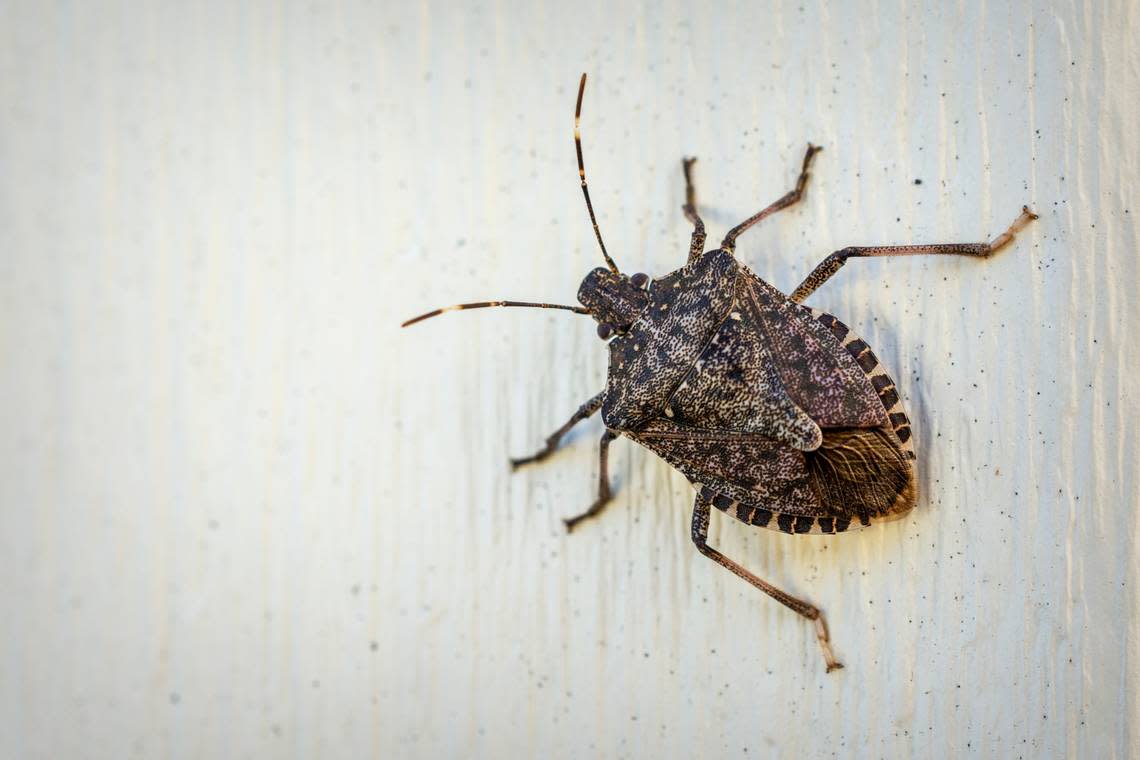We asked WA residents for advice on dealing with stink bugs. Here’s what they said
A couple of weeks ago, we asked readers in a survey if their houses had been infested by the infamous brown marmorated stink bug and what they did to get rid of them.
The invasive bug, originally from Asia, first arrived in Washington about a decade ago. Ever since, the insects have found warm refuge in people’s homes every fall and winter. As temperatures slowly start to warm, the insects decide it’s time to crawl out from their hiding spots and reveal themselves to the world.
We wanted to know where you find the pesky insects and how often you see them, non-toxic ways of getting rid of them, and tips and tricks on keeping them out of your house for the future. More than 90 people sent in responses about their stink bug experiences. Here’s what you told us:
Where do you find stink bugs?
Readers most commonly found stink bugs around indoor living spaces such as the kitchen, dining room, bathroom, bedroom and in doorways. Some readers also find the pests in their fireplaces, garages, sheds, and on the side of and behind picture frames.
Other popular stink bug spots include windows or window sills, lamps or other light fixtures, or rooms with skylights. According to previous reporting from The News Tribune, brown marmorated stink bugs are attracted to light. Multiple readers pointed out finding the insects crawling specifically on the west- or south-facing windows. That likely occurs because the sun sets closer to the southern hemisphere during winter.
Some readers have reported discovering the insects crawling on their bodies.
“They like to hide in between clothes, in the dresser, or even on the walls to the side tables; it’s the scariest thing as they seem to just pop up out of nowhere like a jump scare,” Emily from Whatcom County wrote.

How often do you see them?
Many of you described seeing the pests at varying times of year. For instance, readers stated they saw them commonly during summer, fall and winter.
A few residents said they had encountered the bugs infrequently. But the overwhelming majority see them multiple times a week, daily or several times a day.
“Daily — 6-10 a day recently — in Sammamish. I have a problem!” Leslie from King County wrote.
Multiple people pointed out they were encountering noticeably more stink bugs starting last fall compared to any time before.
How do you get rid of them?
Readers told us several ways they handled the stink bug disturbances. Most of you said you either flush them down the toilet, catch and release them outside or place them in the garbage. Others were less merciful.
“I gently escort them out of the home and then bring violent, swift death from above ...,” wrote Timothy of Pierce County, describing the instrument of death as the heel of his shoe.
Squishing the bugs inside the house might not be the best approach, as the smell their bodies secret invites more of them inside, according to previous reporting from The News Tribune.
Aside from flushing, tossing and curb-stomping, several Washington residents said they put the insects in soapy water to kill them. One reader suggested squirting a mix of clove and spearmint oil in diluted white vinegar to drown them.
Another reader, Karen from Pierce County, wrote in detail how she removes the pests on the outside walls of her house: “Fill a wide mouth jar with half full of water and a drop or two of detergent, hold it tight to the house at a bit of an angle directly under the bug. They tend to propel themselves off the wall and flop into the jar.”
In contrast to those methods, a few of you were more tolerant. One writer said they don’t try to eliminate them because “they do no harm.” Another person said they carry them outside to their plants.

Tricks to keep bugs away
Most readers don’t have any unique tactics for deterring the bugs from entering their homes. But several of you provided a few tips:
As we noted earlier, the insects are attracted to heat and light. One reader said keeping the heat low and lights turned off has worked for them.
Another reader said spraying the outside of their house with minty soap water appeared to help. The News Tribune previously reported that the invasive insects hate mint.
If you see the pests in your chimney, one reader suggests using a foam sealant, silicone rubber or mesh screens.
“Look for any openings around windows, vents, and doors where they might crawl in, and caulk or use weather stripping to keep them from coming in next winter. Any chemical treatment will also affect desired bugs,” Karlina from Pierce County wrote.
If you don’t want to deal with the insects, a pet might be happy to do it for you. “My Border Collie pup herds them. Then eats them,” Mike in Pierce County wrote. Although stink bugs are not poisonous to pets, your furry friends will probably get an upset stomach from munching on them.
